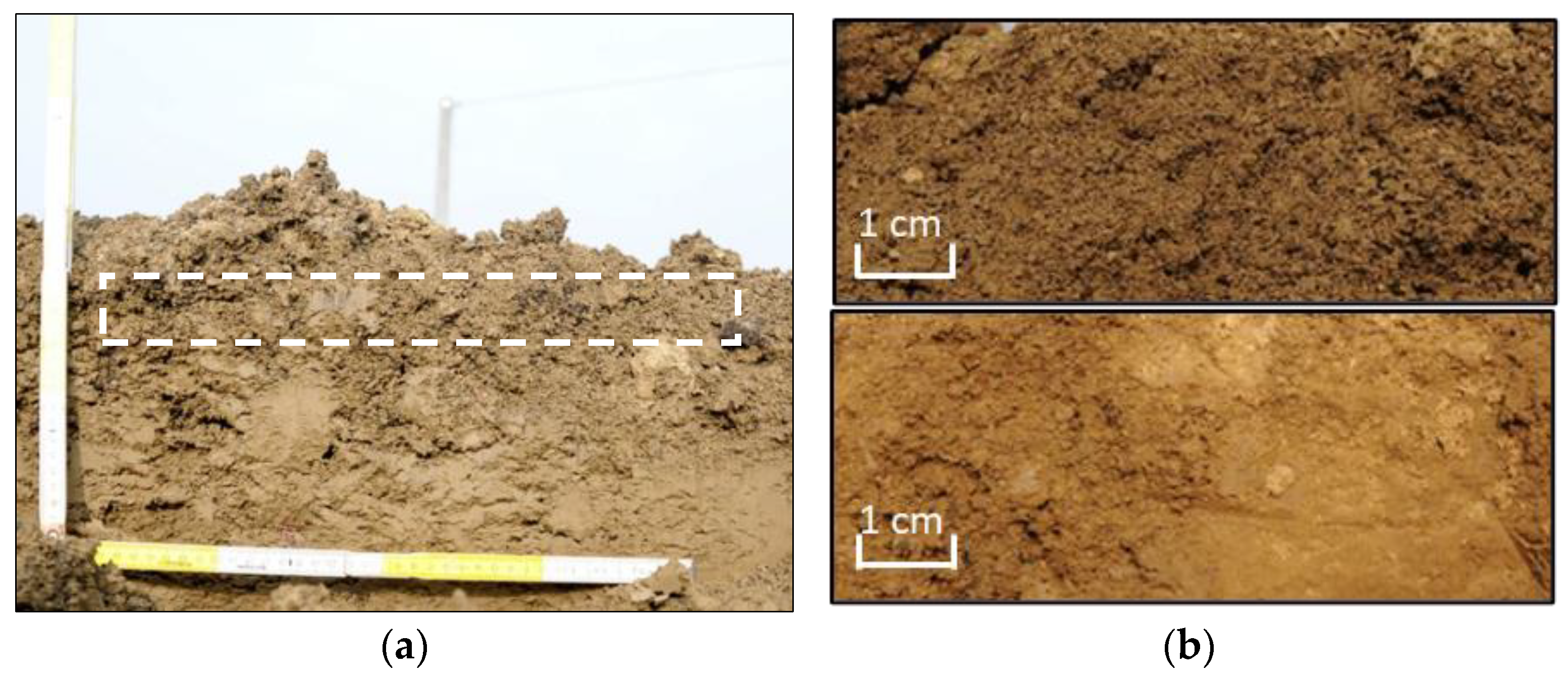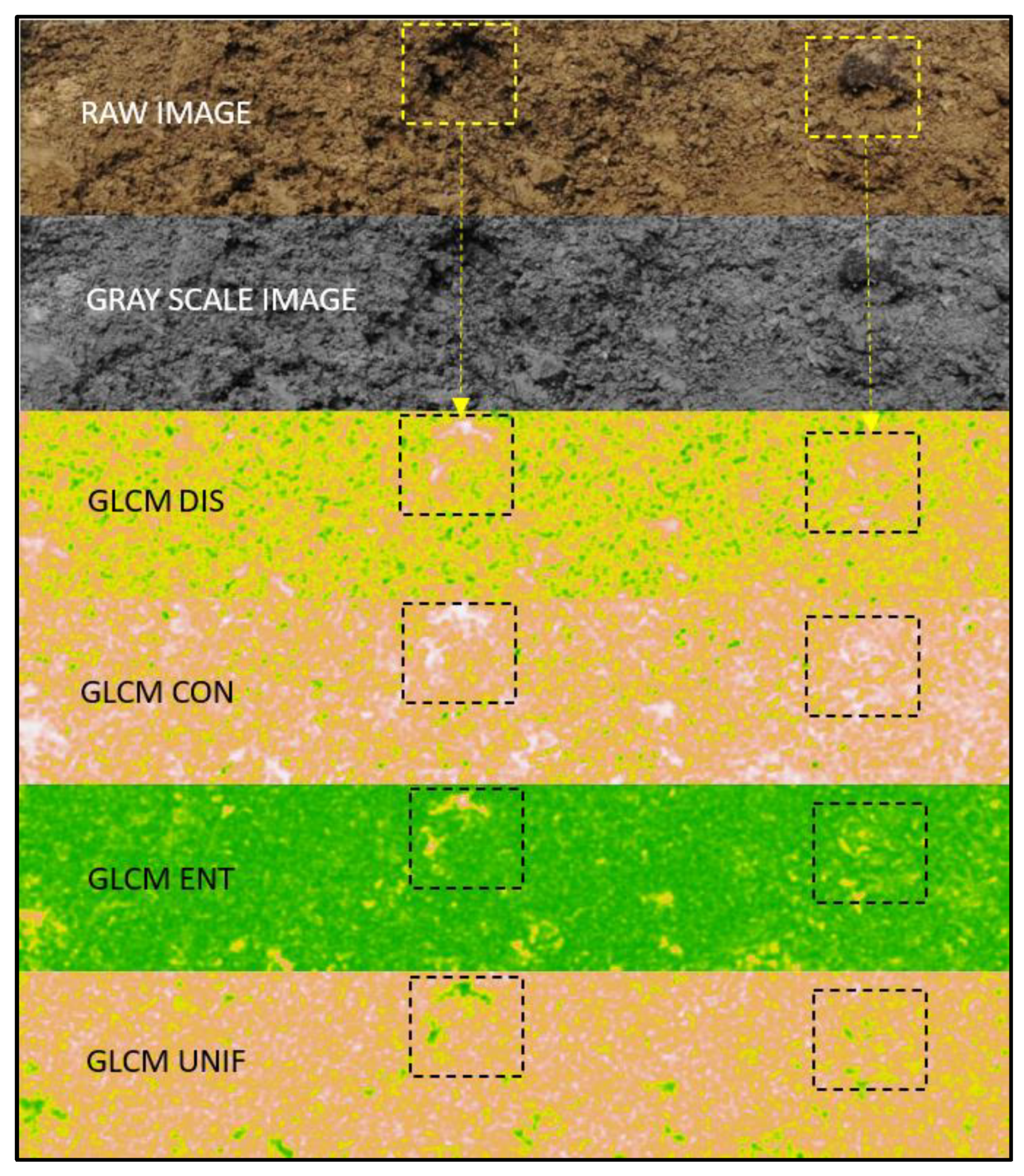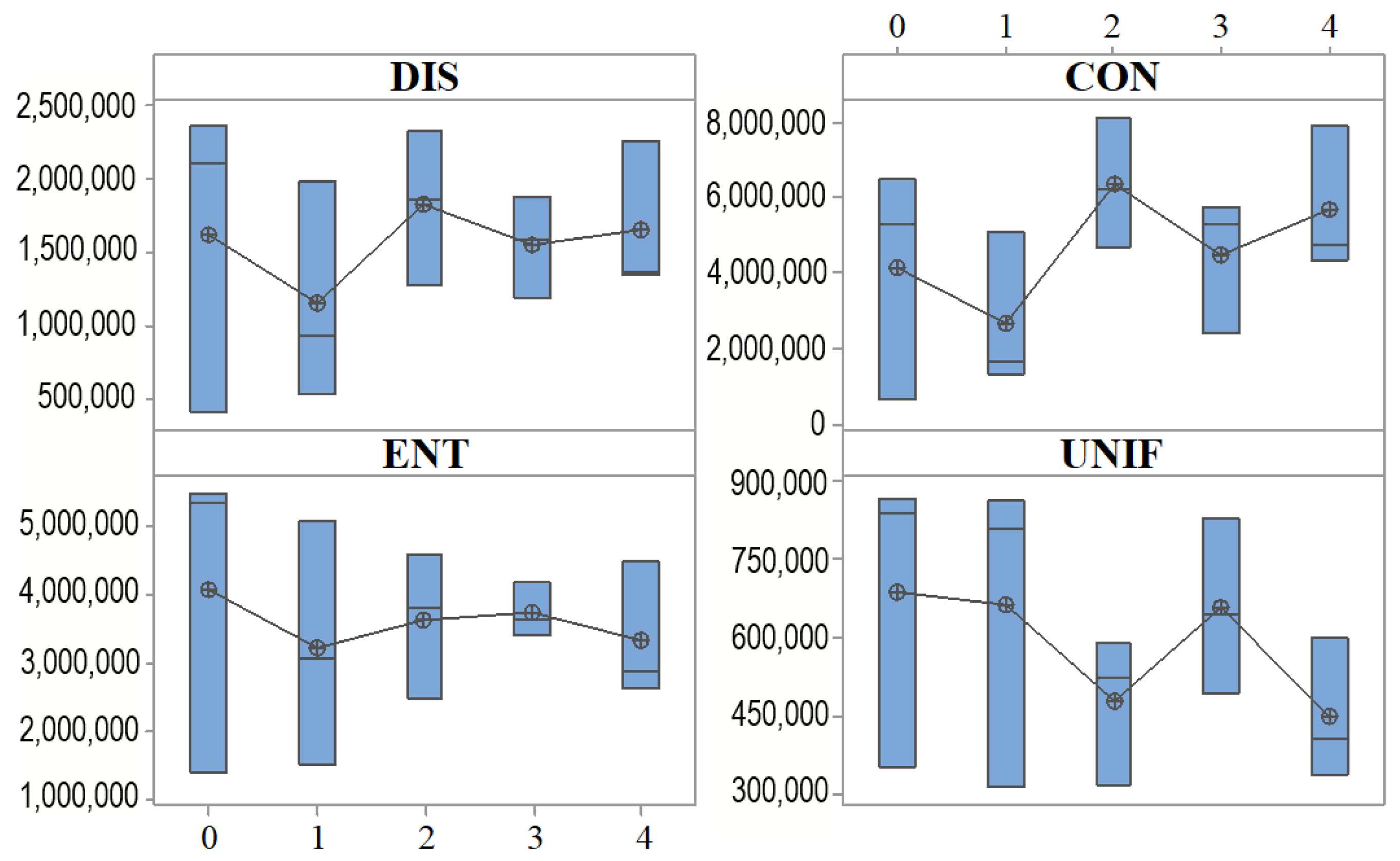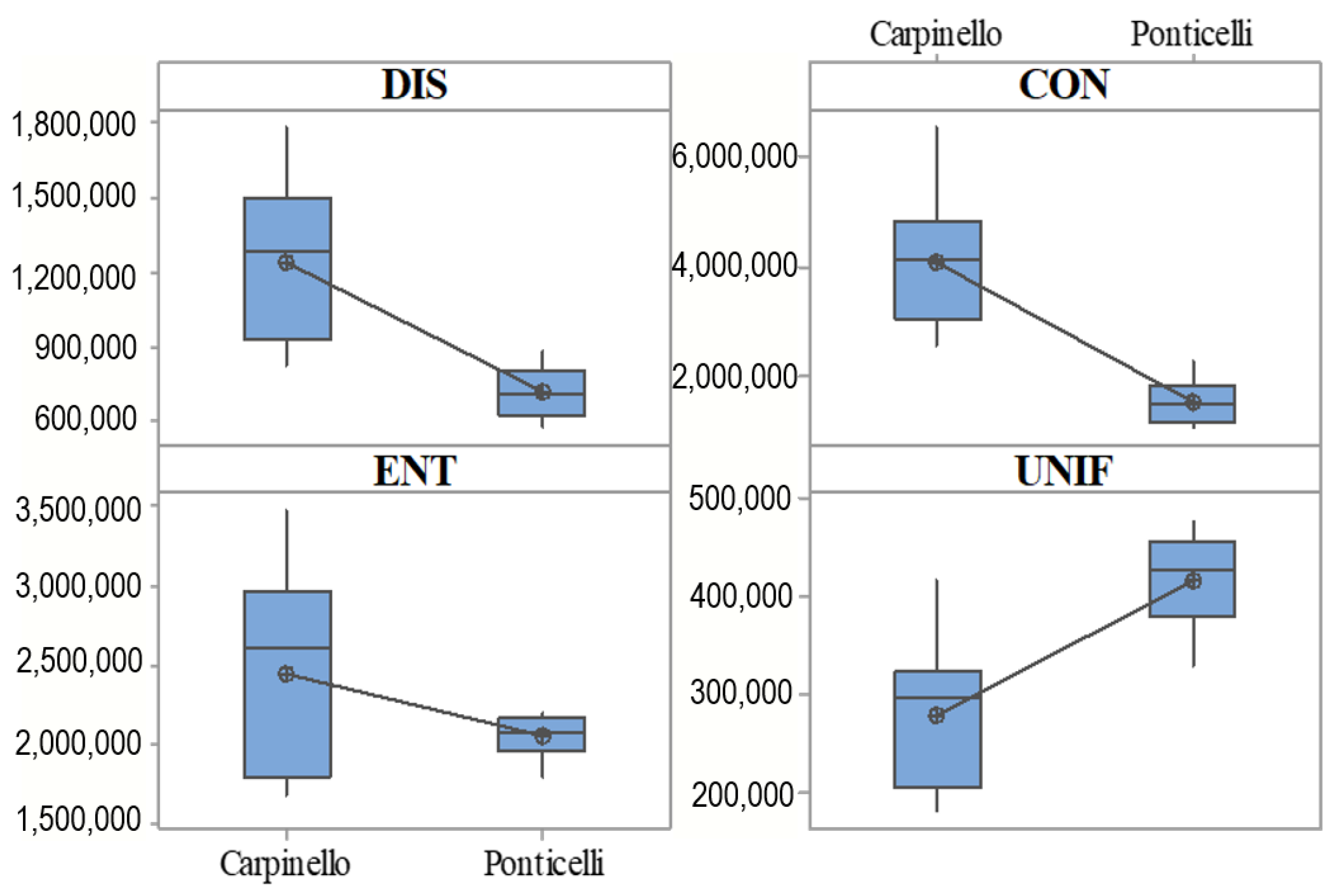Using Image Texture Analysis to Evaluate Soil–Compost Mechanical Mixing in Organic Farms
Abstract
1. Introduction
2. Materials and Methods
2.1. Compost Distribution and Soil Mixing
2.2. Image Acquisition
2.3. Tuning of the Method in Laboratory Conditions
2.4. Image Processing
3. Results
4. Discussion
5. Conclusions
Author Contributions
Funding
Institutional Review Board Statement
Data Availability Statement
Acknowledgments
Conflicts of Interest
References
- Broderson, W.D.; Fortner, J.R. From the Surface Down: An Introduction to Soil Surveys for Agronomic Use; U.S. Department of Agriculture, Soil Conservation Service, National Employee Development Staff: Washington, DC, USA, 2010. Available online: https://nrcspad.sc.egov.usda.gov/DistributionCenter/pdf.aspx?productID=449 (accessed on 12 April 2023).
- Kucerik, J.; Tokarski, D.; Demyan, M.S.; Merbach, I.; Siewert, C. Linking soil organic matter thermal stability with contents of clay, bound water, organic carbon and nitrogen. Geoderma 2018, 316, 38–46. [Google Scholar] [CrossRef]
- Hinsinger, P. Discussion Paper: Soil Organic Matter content in Mediterranean Regions (Both Arable and Permanent Crops). 2014. Available online: https://ec.europa.eu/eip/agriculture/sites/agri-eip/files/fg5_soil_organic_matter_starting_paper_2014_en.pdf (accessed on 12 April 2023).
- Shober, A.L.; Sims, J.T.; Maguire, R.O. Manure Management. In Reference Module in Earth Systems and Environmental Sciences; Elsevier: Amsterdam, The Netherlands, 2018. [Google Scholar] [CrossRef]
- Erhart, E.; Hartl, W. Compost Use in Organic Farming. In Genetic Engineering, Biofertilisation, Soil. Quality and Organic Farming. Sustainable Agriculture Reviews; Lichtfouse, E., Ed.; Springer: Dordrecht, The Netherlands, 2010; Volume 4. [Google Scholar]
- Colomb, B.; Carof, M.; Aveline, A.; Bergez, J.A. Stockless organic farming: Strengths and weaknesses evidenced by a multicriteria sustainability assessment model. Agron. Sustain. Dev. 2013, 33, 593–608. [Google Scholar] [CrossRef]
- Huang, M.; Zhu, Y.; Li, Z.; Huang, B.; Luo, N.; Liu, C.; Zeng, G. Compost as a Soil Amendment to Remediate Heavy Metal-Contaminated Agricultural Soil: Mechanisms, Efficacy, Problems, and Strategies. Wat. Air Soil. Poll. 2016, 227, 227–359. [Google Scholar] [CrossRef]
- Reina, R.; Ullrich, R.; García-Romera, I.; Liers, C.; Aranda, E. Integrated biovalorization of wine and olive mill by-products to produce enzymes of industrial interest and soil amendments. Span. J. Agric. Res. 2016, 14, e0205. [Google Scholar] [CrossRef]
- El-Bassi, L.; Azzaz, A.A.; Jellali, S.; Akrout, H.; Marks, E.A.N.; Ghimbeu, C.M.; Jeguirim, M. Application of olive mill waste-based biochars in agriculture: Impact on soil properties, enzymatic activities and tomato growth. Sci. Total Environ. 2021, 755, 142531. [Google Scholar] [CrossRef] [PubMed]
- Reeve, J.R.; Hoagland, L.A.; Villalba, J.J.; Carr, P.M.; Atucha, A.; Cambardella, C.; Davis, D.R.; Delate, K. Organic Farming, Soil Health, and Food Quality: Considering Possible Links. Adv. Agron. 2016, 137, 319–367. [Google Scholar]
- Standard ASAE S341.4; Procedure for Measuring Distribution Uniformity and Calibrating Granular Broadcast Spreaders. ASABE—American Society of Agricultural and Biological Engineers: St. Joseph, MI, USA, 2015.
- Grafton, M.; Yule, I.; Manning, M. A review of practices in precision application of granular fertilizers. In Proceedings of the 7th Asian-Australasian Conference on Precision Agriculture, Hamilton, New Zealand, 16–18 October 2017. [Google Scholar]
- EN ISO 4254-8:2018; Agricultural Machinery-Safety-Part 8: Solid Fertilizer Distributors. ISO: Geneva, Switzerland, 2018.
- Tissot, S.; Miserque, O.; Mostade, O.; Huyghebaert, B.; Destain, J.P. Uniformity of N-fertiliser spreading and risk of ground water contamination. Irrig. Drain. 2002, 51, 17–24. [Google Scholar] [CrossRef]
- Vasilica, S.; Ladislau, D.; Radu, C.; Ana, Z.; Ancuta, N.; Albert, S. Experimental testing of a helical rotor for compost distribution. E3S Web Conf. 2020, 180, 03027. [Google Scholar] [CrossRef]
- Romano, E.; Brambilla, M.; Bisaglia, C.; Pampuro, N.; Pedretti, E.F.; Cavallo, E. Pelletization of composted swine manure solid fraction with different organic co-formulates: Effect of pellet physical properties on rotating spreader distribution patterns. Int. J. Rec. Org. Waste Agric. 2014, 3, 101–111. [Google Scholar] [CrossRef]
- Manetto, G.; Cerruto, E.; Papa, R.; Selvaggi, R.; Pecorino, B. Performance evaluation of digestate spreading machines in vineyards and citrus orchards: Preliminary trials. Heliyon 2020, 6, e04257. [Google Scholar]
- Agidi, G.; Gana, I.M.; Usman, H. Development of an indented cylinder metering device for a tractor drawn manure spreader. IOP Conf. Ser. Earth Environ. Sci. 2020, 445, 012061. [Google Scholar] [CrossRef]
- Sathiamurthi, P.; Anaamalaai, A.S.; Ahamed Buhari, M.R.; Ajimal Thahasin, M. Design and fabrication of manure spreader. Int. J. Sci. Technol. Res. 2020, 9, 5134–5136. [Google Scholar]
- Pagliai, M.; Vignozzi, N. Image Analysis and Microscopic Techniques to Characterize Soil Pore System. In Physical Methods in Agriculture; Blahovec, J., Kutílek, M., Eds.; Springer: Boston, MA, USA, 2002; pp. 13–38. [Google Scholar]
- Zaeem, M.; Nadeem, M.; Pham, T.H.; Ashiq, W.; Ali, W.; Gillani, S.S.M.; Moise, E.R.D.; Leier, H.; Kavanagh, V.; Galagedara, L.; et al. Development of a hyperspectral imaging technique using LA-ICP-MS to show the spatial distribution of elements in soil cores. Geoderma 2021, 385, 114831. [Google Scholar] [CrossRef]
- Marcal, A.R.S.; Cubha, M. Development of an image-based system to assess agricultural fertilizer spreader pattern. Comput. Electron. Agric. 2019, 162, 380–388. [Google Scholar] [CrossRef]
- Laucka, A.; Adaskeviciute, V.; Andriukaitis, D. Research of the Equipment Self-Calibration Methods for Different Shape Fertilizers Particles Distribution by Size Using Image Processing Measurement Method. Symmetry 2019, 11, 838. [Google Scholar] [CrossRef]
- Hensel, O. A New Methodology for Mapping Fertilizer Distribution. In Proceedings of the 2003 ASAE Annual Meeting, Las Vegas, NV, USA, 27–30 July 2003; p. 031123. [Google Scholar]
- Castellano, G.; Bonilha, L.; Li, L.M.; Cendes, F. Texture analysis of medical images. Clin. Radiol. 2004, 59, 1061–1069. [Google Scholar] [CrossRef]
- Lan, R.; Zhong, S.; Liu, Z.; Shi, Z.; Luo, X. A simple texture feature for retrieval of medical images. Multimed. Tools Appl. 2018, 77, 10853–10866. [Google Scholar] [CrossRef]
- Li, Y.; Lu, Z.; Li, J.; Deng, Y. Improving deep learning feature with facial texture feature for face recognition. Wirel. Pers. Commun. 2018, 103, 1195–1206. [Google Scholar] [CrossRef]
- Akbal, E. An automated environmental sound classification methods based on statistical and textural feature. App Acoust. 2020, 167, 107413. [Google Scholar] [CrossRef]
- Yin, S.; Shao, Y.; Wu, A.; Wang, Y.; Gao, Z. Texture features analysis on micro-structure of paste backfill based on image analysis technology. J. Cent. South. Univ. 2018, 25, 2360–2372. [Google Scholar] [CrossRef]
- Aouat, S.; Ait-hammi, I.; Hamouchene, I. A new approach for texture segmentation based on the Gray Level Co-occurrence Matrix. Multimed. Tools Appl. 2021, 80, 24027–24052. [Google Scholar] [CrossRef]
- Bakheet, S.; Al-Hamadi, A. Automatic detection of COVID-19 using pruned GLCM-Based texture features and LDCRF classification. Comput. Biol. Med. 2021, 137, 104781. [Google Scholar] [CrossRef]
- Lian, M.; Huang, C. Texture feature extraction of gray-level co-occurrence matrix for metastatic cancer cells using scanned laser pico-projection images. Laser Med. Sci. 2019, 34, 1503–1508. [Google Scholar] [CrossRef]
- Rafi, M.; Mukhopadhyay, S. Texture description using multi-scale morphological GLCM. Multimed. Tools Appl. 2018, 77, 30505–30532. [Google Scholar] [CrossRef]
- Srivastava, D.; Rajitha, B.; Agarwal, S.; Singh, S. Pattern-based image retrieval using GLCM. Neural Comput. Appl. 2020, 32, 10819–10832. [Google Scholar] [CrossRef]
- Vimal, S.; Robinson, Y.H.; Kaliappan, M.; Vijayalakshmi, K.; Seo, S. A method of progression detection for glaucoma using K-means and the GLCM algorithm toward smart medical prediction. J. Supercomput. 2021, 77, 11894–11910. [Google Scholar] [CrossRef]
- Alvarado, F.A.P.; Hussein, M.A.; Becker, T.A. Vision System for Surface Homogeneity Analysis of Dough Based on the Grey Level Co-occurrence Matrix (GLCM) for Optimum Kneading Time Prediction. J. Food Process. Eng. 2016, 39, 166–177. [Google Scholar] [CrossRef]
- Hall-Beyer, M. GLCM Texture: A Tutorial v. 3.0 March 2017. 2017. Available online: https://prism.ucalgary.ca/items/8833a1fc-5efb-4b9b-93a6-ac4ff268091c (accessed on 16 May 2023).
- Li, W.; Jiang, X.; Sun, W.; Wang, S.; Liu, C.; Zhang, X.; Zhang, Y.; Zhou, W.; Miao, L. Gingivitis identification via multichannel gray-level co-occurrence matrix and particle swarm optimization neural network. Int. J. Imaging Syst. Technol. 2019, 30, 401–411. [Google Scholar] [CrossRef]
- Lloyd, K.; Rosin, P.L.; Marshall, D.; Moore, S.C. Detecting violent and abnormal crowd activity using temporal analysis of grey level co-occurrence matrix (GLCM)-based texture measures. Mach. Vision. Appl. 2017, 28, 361–371. [Google Scholar] [CrossRef]
- Oghaz, M.M.; Maarof, M.A.; Rohani, M.F.; Zainal, A.; Shaid, S.Z.M. An optimized skin texture model using gray-level cooccurrence matrix. Neural Comput. Appl. 2019, 31, 1835–1853. [Google Scholar] [CrossRef]
- Olaniyi, E.O.; Adekunle, A.A.; Odekuoye, T.; Khashman, A. Automatic system for grading banana using GLCM texture feature extraction and neural network arbitrations. J. Food Process. Eng. 2017, 40, e12575. [Google Scholar] [CrossRef]
- Raju, P.; Rao, V.M.; Rao, B.P. Optimal GLCM combined FCM segmentation algorithm for detection of kidney cysts and tumor. Multimed. Tools Appl. 2019, 78, 18419–18441. [Google Scholar] [CrossRef]
- Singh, A.; Armstrong, R.T.; Regenauer-Lieb, K.; Mostaghimi, P. Rock Characterization Using Gray-Level Co-Occurrence Matrix: An Objective Perspective of Digital Rock Statistics. Water Resour. Res. 2018, 55, 1912–1927. [Google Scholar] [CrossRef]
- Tahir, M.A.; Bouridane, A.; Kurugollu, K. An FPGA Based Coprocessor for GLCM and Haralick Texture Features and their Application in Prostate Cancer Classification. Analog. Integr. Circuits Signal. Process. 2005, 43, 205–215. [Google Scholar] [CrossRef]
- Varish, N.; Pal, A.K. A novel image retrieval scheme using gray level co-occurrence matrix descriptors of discrete cosine transform based residual image. Appl. Intell. 2018, 48, 2930–2953. [Google Scholar] [CrossRef]
- Sagayaraj, A.S.; Kabilesh, S.K.; Mohanapriya, D.; Anandkumar, A. Determination of Soil Moisture Content using Image Processing-A Survey. In Proceedings of the 6th International Conference on Inventive Computation Technologies (ICICT), Coimbatore, India, 20–22 January 2021; pp. 1101–1106. [Google Scholar] [CrossRef]
- Akhavan, Z.; Hasanlou, M.; Hosseini, M.; Becker-Reshef, I. Soil moisture retrieval improvement over agricultural fields by adding entropy–alpha dual-polarimetric decomposition features. J. Appl. Remote Sens. 2021, 15, 034516. [Google Scholar] [CrossRef]
- Zhao, Y.; Zhang, Z.; Zhu, H.; Ren, J. Quantitative Response of Gray-Level Co-Occurrence Matrix Texture Features to the Salinity of Cracked Soda Saline–Alkali Soil. Int. J. Environ. Res. Public Health 2022, 19, 6556. [Google Scholar] [CrossRef]
- Castillo-Santiago, M.A.; Ricker, M.; de Jong, B.H.J. Estimation of tropical forest structure from SPOT-5 satellite images. Int. J. Remote Sens. 2010, 31, 2767–2782. [Google Scholar] [CrossRef]
- Zhao, P.; Lu, D.; Wang, G.; Liu, L.; Li, D.; Zhu, J.; Yu, S. Forest aboveground biomass estimation in Zhejiang Province using the integration of Landsat TM and ALOS PALSAR data. Int. J. Appl. Earth Obs. Geoinf. 2016, 53, 1–15. [Google Scholar] [CrossRef]
- Ozdemir, I.; Norton, D.A.; Ozkan, U.Y.; Mert, A.; Senturk, O. Estimation of Tree Size Diversity Using Object Oriented Texture Analysis and Aster Imagery. Sensors 2008, 8, 4709–4724. [Google Scholar] [CrossRef]
- Wang, H.; Zhao, Y.; Pu, R.; Zhang, Z. Mapping Robinia Pseudoacacia Forest Health Conditions by Using Combined Spectral, Spatial, and Textural Information Extracted from IKONOS Imagery and Random Forest Classifier. Remote Sens. 2015, 7, 9020–9044. [Google Scholar] [CrossRef]
- Shihavuddin, A.S.M.; Gracias, N.; Garcia, R.; Gleason, A.C.R.; Gintert, B. Image-Based Coral Reef Classification and Thematic Mapping. Remote Sens. 2013, 5, 1809–1841. [Google Scholar] [CrossRef]
- Zhao, S.; Schmidt, S.; Gao, H.; Li, T.; Chen, X.; Hou, Y.; Chadwick, D.; Tian, J.; Dou, Z.; Zhang, W.; et al. A precision compost strategy aligning composts and application methods with target crops and growth environments can increase global food production. Nat. Food 2022, 3, 741–752. [Google Scholar] [CrossRef] [PubMed]
- Zdruli, P.; Jones, R.J.A.; Montanarella, L. Organic Matter in the Soils of Southern Europe. In European Soil Bureau Technical Report, EUR 21083 EN, (2004), 16pp; Office for Official Publications of the European Communities: Luxembourg, 2004. [Google Scholar]
- Grilli, E.; Carvalho, S.C.P.; Chiti, T.; Coppola, E.; D’Ascoli, R.; La Mantia, T.; Marzaioli, R.; Mastrocicco, M.; Pulido, F.; Rutigliano, F.A.; et al. Critical range of soil organic carbon in southern Europe lands under desertification risk. J. Environ. Manag. 2021, 287, 112285. [Google Scholar] [CrossRef]
- Emilia Romagna Region. Local benchmark Sites of Emilia-Romagna Soils-Environment. 2013. Available online: https://ambiente.regione.emilia-romagna.it/en/geologia/soil/benchmark-local-sites-of-emilia-romagna-soils (accessed on 6 May 2023).
- Assirelli, A.; Fornasier, F.; Caputo, F.; Manici, L. Locally available compost application in organic farms: 2-year effect on biological soil properties. Renew. Agric. Food Syst. 2023, 38, E16. [Google Scholar] [CrossRef]
- Ortiz, O.; Casanellas, J.P.; Rodríguez, C.D.A. Criteria and recommendations for capturing and presenting soil profile images in order to create a database of soil images. Span. J. Soil Sci. 2014, 4, 112–126. [Google Scholar]
- R Core Team. R: A Language and Environment for Statistical Computing; R Foundation for Statistical Computing: Vienna, Austria, 2019; Available online: https://www.R-project.org/ (accessed on 12 April 2023).
- Hijmans, R.J. Raster: Geographic Data Analysis and Modeling. R Package Version 3.5-15. 2022. Available online: https://CRAN.R-project.org/package=raster (accessed on 12 April 2023).
- Haralick, R.M.; Shanmugam, K.; Dinstein, I. Textural Features for Image Classification. IEEE Trans. Syst. Man Cybern. 1973, SMC-3, 610–621. [Google Scholar] [CrossRef]
- Zvoleff, A. Glcm: Calculate Textures from Grey-Level Co-Occurrence Matrices (GLCMs). R package Version 1.6.5. 2020. Available online: https://CRAN.R-project.org/package=glcm (accessed on 12 April 2023).
- Beliakov, G.; James, S.; Troiano, L. Texture recognition by using GLCM and various aggregation functions. In Proceedings of the 2008 IEEE International Conference on Fuzzy Systems (IEEE World Congress on Computational Intelligence), Hong Kong, China, 1–6 June 2008. [Google Scholar]
- Aborisade, D.O.; Ojo, J.A.; Amole, A.O.; Durodola, A.O. Comparative analysis of textural features derived from GLCM of Ultrasound Liver Classification. Int. J. Emerg. Trends Technol. Comp. Sci. 2014, V11, 239–244. [Google Scholar]
- Pagliai, M.; Vignozzi, N.; Pellegrini, S. Soil structure and the effect of management practices. Soil Tillage Res. 2004, 79, 131–143. [Google Scholar] [CrossRef]
- Armi, L.; Fekri-Ershad, S. Texture image analysis and texture classification methods-A review. Int. Online J. Image Proc. Pattern Rec. 2019, 2, 1–29. [Google Scholar]
- Partio, M.; Cramariuc, B.; Gabbouj, M. Visa, Rock texture retrieval using gray level co-occurrence matrix. In Proceedings of the 5th Nordic Signal Processing Symposium, NORSIG 2002, Tromso-Trondheim, Norway, 4–7 October 2002. [Google Scholar]
- Huang, X.; Liu, X.; Zhang, L. A Multichannel Gray Level Co-Occurrence Matrix for Multi/Hyperspectral Image Texture Representation. Remote Sens. 2014, 6, 8424–8445. [Google Scholar] [CrossRef]
- Umaselvi, M.; Kumar, S.S.; Athithya, M. Color Based Urban and Agricultural Land Classification by GLCM Texture Features. In Proceedings of the IET Chennai 3rd International Conference on Sustainable Energy and Intelligent Systems (SEISCON 2012), Tiruchengode, India, 27–29 December 2012; pp. 92–195. [Google Scholar]
- Kupidura, P. The Comparison of Different Methods of Texture Analysis for Their Efficacy for Land Use Classification in Satellite Imagery. Remote Sens. 2019, 11, 1233. [Google Scholar] [CrossRef]
- Iqbal, N.; Mumtaz, R.; Shafi, U.; Zaidi, S.M.H. Gray level co-occurrence matrix (GLCM) texture based crop classification using low altitude remote sensing platforms. PeerJ Comput. Sci. 2021, 7, e536. [Google Scholar] [CrossRef] [PubMed]
- Alsaif, K.I.; Mohi Al-Deen, S.M. Skin Classification Based on Co-occurance Matrix. Raf. J. Comp. Math’s 2010, 7, 41–51. [Google Scholar] [CrossRef]
- Pantic, I.; Cumic, J.; Dugalic, S.; Petroianu, G.A.; Corridon, R.P. Gray level co-occurrence matrix and wavelet analyses reveal discrete changes in proximal tubule cell nuclei after mild acute kidney injury. Sci. Rep. 2023, 13, 4025. [Google Scholar] [CrossRef] [PubMed]
- Hall-Beyer, M. Practical guidelines for choosing GLCM textures to use in landscape classification tasks over a range of moderate spatial scales. Int. J. Remote Sens. 2017, 38, 1312–1338. [Google Scholar] [CrossRef]
- Cadena-Zapata, M.; Hoogmoed, W.B.; Perdok, U.D. Field studies to assess the workable range of soils in the tropical zone of Veracruz, Mexico. Soil Tillage Res. 2002, 68, 83–92. [Google Scholar] [CrossRef]
- Oduma, O.; Oluka, S.I.; Eze, P.C. Effect of soil physical properties on performance of agricultural field machinery in south eastern Nigeria. Agric. Eng. Int. CIGR J. 2018, 20, 25–31. [Google Scholar]





| Soil Characteristics | Carpinello | Ponticelli |
|---|---|---|
| Sand (%) | 5.31 | 25.52 |
| Silt (%) | 47.59 | 51.68 |
| Clay (%) | 47.10 | 22.80 |
| SOM (g kgsoil−1) | 1.66 | 2.04 |
| P2O5 (g kgsoil−1) | 32.0 | 42.0 |
| K2O (g kgsoil−1) | 542.0 | 159.0 |
| pH | 8.0 | 7.7 |
| SA Characteristics | Average Content Range |
|---|---|
| Moisture (%) | 22–32 |
| pH | 6.5–7.5 |
| Organic carbon (% d.m.) 1 | 22–26 |
| Humic and fulvic carbon (% d.m.) | 6.0–8.0 |
| Total N (% d.m.) | 1.2–1.8 |
| Organic N (% d.m.) | 1.2–1.8 |
| C/N ratio | 15–19 |
| Salinity (meq/100 gd.m.) | 19–52 |
| P (% d.m. as P2O5) | 0.4–0.6 |
| K (% d.m. as K2O) | 1.0–1.2 |
Disclaimer/Publisher’s Note: The statements, opinions and data contained in all publications are solely those of the individual author(s) and contributor(s) and not of MDPI and/or the editor(s). MDPI and/or the editor(s) disclaim responsibility for any injury to people or property resulting from any ideas, methods, instructions or products referred to in the content. |
© 2023 by the authors. Licensee MDPI, Basel, Switzerland. This article is an open access article distributed under the terms and conditions of the Creative Commons Attribution (CC BY) license (https://creativecommons.org/licenses/by/4.0/).
Share and Cite
Romano, E.; Brambilla, M.; Bisaglia, C.; Assirelli, A. Using Image Texture Analysis to Evaluate Soil–Compost Mechanical Mixing in Organic Farms. Agriculture 2023, 13, 1113. https://doi.org/10.3390/agriculture13061113
Romano E, Brambilla M, Bisaglia C, Assirelli A. Using Image Texture Analysis to Evaluate Soil–Compost Mechanical Mixing in Organic Farms. Agriculture. 2023; 13(6):1113. https://doi.org/10.3390/agriculture13061113
Chicago/Turabian StyleRomano, Elio, Massimo Brambilla, Carlo Bisaglia, and Alberto Assirelli. 2023. "Using Image Texture Analysis to Evaluate Soil–Compost Mechanical Mixing in Organic Farms" Agriculture 13, no. 6: 1113. https://doi.org/10.3390/agriculture13061113
APA StyleRomano, E., Brambilla, M., Bisaglia, C., & Assirelli, A. (2023). Using Image Texture Analysis to Evaluate Soil–Compost Mechanical Mixing in Organic Farms. Agriculture, 13(6), 1113. https://doi.org/10.3390/agriculture13061113









